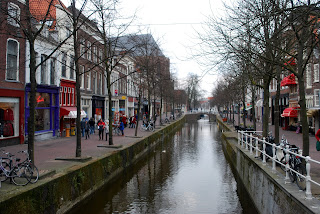Since moving to The Netherlands we have been to quite a few different countries but have not seen much of the Netherlands outside Amsterdam, so this Easter long weekend we decided to explore Limburg, the southern most province of The Netherlands. We hired a car to give us a bit of freedom in where we could go, and it was the first time that either of us have driven on the right-hand side of the road- the 'wrong' side as far as us Australians are concerned. It took some getting used to (I was constantly hitting my left hand against the door as I instinctively went to change gears, and the windscreen wipers were applied instead of the indicators at almost every single corner) but aside from a few nervous moments in the centre of Amsterdam where roads are narrow and bikes are many, there were no issues.
 |
| Delft Markt Square |
Our first stop was at Delft, a cute but touristy little town about an hour outside Amsterdam which is most famous for its blue painted porcelain. There was actually a few specs of snow falling as we wandered through the canals, enjoying fresh stroopwaffels and chocolate muffins from the markets. The two big churches, creatively named Oude and Nieuwe Kerk, both had beautiful stained glass windows and are the resting places of quite a few famous Dutch historical figures including Prince Willem van Oranje and Vermeer.The main Markt square was surrounded by many typical old Dutch buildings and it would have been a great place to enjoy a drink on a sunny afternoon- not so much in the freezing wind. Instead we had lunch at a little cafe called De Oude Jan, which is next to and gets its name from the Oude Kerk's nickname 'Oude Jan' (Old John).
 |
| Kroketten and turine |
 |
| Zoervleis |
On Sunday we started with coffee and appelvlaai at a cafe on the river. Coffee was harder to find than we expected as almost everything was closed due to Easter weekend. The walk along the river was quite nice and we ended up in the park near the medieval town wall. We walked back through the winding streets, and in the afternoon headed to Aachen, a small town just over the German border which has a big cathedral with a beautiful gold and blue ceiling. We also visited the town hall which had lots of information about the city, before attempting to drive to Drielandenpunt (the Three Countries Point) where the borders of Germany, Belgium and the Netherlands meet.
 |
| Appelvlaai |
 |
| Maas River |
 |
| Old Maastricht town walls |
The GPS tried to take us along the shortest route which unfortunately included a very narrow, steep, one way dirt road which eventually became pedestrian only, and when the sun started to go down and the snow started to fall it became a little worrying. We eventually found an alternate road (coming from the Dutch side rather than the German side) which was nice, wide and paved, so we were able to visit the point which is also the highest point in European Netherlands. Although at 322m, it was not particularly impressive- in comparison, Australia's Mt Kosciuszko is 2228m and Mt Everest is almost 9000m high.
 |
| Aachen main square |
 |
| Inside the Aachen cathedral |
 |
| Drielandenpunt |
 |
| Highest point in the Netherlands |
On Monday morning we visited the parts of Maastricht that we had not yet seen, including Basilica of St Servatius and the striking red tower of Sint Janskerk. We were told that the type of stone which the tower is made from easily absorbs dirt and dust from the air, causing the tower to turn a dirty grey colour which did not impress the locals, so it was a tradition from some hundreds of years ago to paint the tower a more attractive colour.
 |
| Basilica of St Servatius and Sint Janskerk |
We also took a 20 minutes walk to the nearby St Petersburg caves, a large series of underground tunnels which was at one point the largest man-made tunnel system in the world (apparently recently overtaken by a system in Vietnam). The tour of the tunnels was very interesting and included information about the discovery of dinosaurs in the area (Mosasaurs, named after the river Maas on which Maastricht lies) and the use of the tunnels as hiding places during wars, including the Napoleonic invasion and WWII.
 |
| St Petersburg Fort |
 |
| Artist's impression of the dinosaurs found in Maastricht area, drawn on the cave walls |
Before the drive home, we enjoyed one last Limburgse experience- a delicious piece of Limburgse rijstavlaai while sitting on the Vrijthof.













































No comments:
Post a Comment